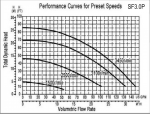I like investigating/poking around with things and started looking into the flow rate for my pool equipment. I understand flow rate isn't all that important but I'm curious nonetheless.
Is there a reason behind the recommended flow rate charts? I've seen the 8 fps/10 fps charts and the corresponding flow rates, just curious why this is the standard.
I hooked up a vacuum gauge to the pump suction drain port and installed the nifty filter pressure gauge from TfTests (it's a nice gauge btw!).
I tested my pump (CircuPool 3hp VS) at three different speeds (3000, 2500 and 1500 rpm) and this is what I got:
3000 rpm
Vacuum -8.25 Hg
Pressure 13.5 psi
-8.25 x 1.13 = 9.3225
13.5 x 2.31 = 31.185
Total 40.5075
90 gpm?
2500 rpm
Vacuum -6 Hg
Pressure 9 psi
-6 x 1.13 = 6.78
9 x 2.31 = 20.79
Total = 27.57
70 gpm?
1500 rpm
Vacuum -2.5 Hg
Pressure 2.25 psi
-2.5 x 1.13 = 2.825
2.25 x 2.31 = 5.1975
Total = 8.0225
45 gpm?
Here is the relevant performance curve from CircuPool:

Based on the 8 fps/10 fps chart (for 1.5" piping that equals 50 gpm/62 gpm) it seems like 1500 rpm is slower than recommended and 2500 rpm is too fast. Should I care enough to adjust my pump speed/schedule to try and get close to the recommended flow rate or does it really not matter?
Is there a reason behind the recommended flow rate charts? I've seen the 8 fps/10 fps charts and the corresponding flow rates, just curious why this is the standard.
I hooked up a vacuum gauge to the pump suction drain port and installed the nifty filter pressure gauge from TfTests (it's a nice gauge btw!).
I tested my pump (CircuPool 3hp VS) at three different speeds (3000, 2500 and 1500 rpm) and this is what I got:
3000 rpm
Vacuum -8.25 Hg
Pressure 13.5 psi
-8.25 x 1.13 = 9.3225
13.5 x 2.31 = 31.185
Total 40.5075
90 gpm?
2500 rpm
Vacuum -6 Hg
Pressure 9 psi
-6 x 1.13 = 6.78
9 x 2.31 = 20.79
Total = 27.57
70 gpm?
1500 rpm
Vacuum -2.5 Hg
Pressure 2.25 psi
-2.5 x 1.13 = 2.825
2.25 x 2.31 = 5.1975
Total = 8.0225
45 gpm?
Here is the relevant performance curve from CircuPool:

Based on the 8 fps/10 fps chart (for 1.5" piping that equals 50 gpm/62 gpm) it seems like 1500 rpm is slower than recommended and 2500 rpm is too fast. Should I care enough to adjust my pump speed/schedule to try and get close to the recommended flow rate or does it really not matter?
Last edited:

